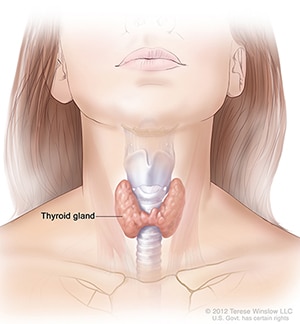Over this month and next, we will explore how the thyroid gland affects vision. The thyroid is essentially your body’s hormone factory. Shaped like a butterfly, it’s in the lower front of your neck, just below your Adam’s apple. The American Thyroid Association says hormones secrete into the blood and are then carried to every tissue within the body. These hormones help your body use energy, stay warm and keep the brain, heart, muscles, and other organs working as they should. This includes the eyes.
When the thyroid malfunctions, it tends to either create too much hormone, a condition called hyperthyroidism, or too little, known as hypothyroidism. Both conditions can adversely affect the eyes. In our two-part series on this important gland and its function in the human body, we are going to separate these two conditions and explore them more thoroughly. This month’s blog post will focus on hyperthyroidism and next month, we will look at hypothyroidism.
What is Hyperthyroidism?
Think of your thyroid as the gas pedal in your car; it controls how fast or slow your body operates. Hyperthyroidism happens when your thyroid gland produces too much hormone thyroxine and speeds up every function in your body. This increase in your metabolism can cause anxiety, sweating, nervousness, heart racing, irregular heartbeat, hand tremors, insomnia, weight loss, brittle hair, increased bowel movements, and muscle weakness.
How Does it Affect the Eyes?
When all of your body processes speed up and become overactive, it can cause inflammation of soft tissues. For your eyes, this happens within the soft tissue of the eye socket itself. This condition is called Graves’ disease, an autoimmune issue, discovered by Robert Graves, an Irish physician. If left untreated, Graves’ disease can lead to compression of the optic nerve and may damage the cornea. The compression of the optic nerve usually results in double vision and in rare cases, may lead to vision loss.
Symptoms to Watch For
Johns Hopkins’ Wilmer Eye Institute says to watch for these symptoms and early warning signs of Graves’ disease:
- Redness, swelling, difficulty closing eyelids.
- Excessive tearing from dry eyes.
- Bulging of eyes (a common characteristic of Graves’ disease).
- Increased pain and pressure behind the eye.
- Increased swelling.
In advanced cases, the cornea can ulcerate, leading to cataracts and perhaps even vision loss.
Treatment
Getting a comprehensive eye exam every year can help to identify the early stages of Graves’ disease. As with nearly everything, early detection can go a long way toward effective treatment. Of course, treating your overactive thyroid will involve working with your primary care physician as well and may include medication to control the thyroid.
Next month, we will examine how an underactive thyroid affects your eyes.


